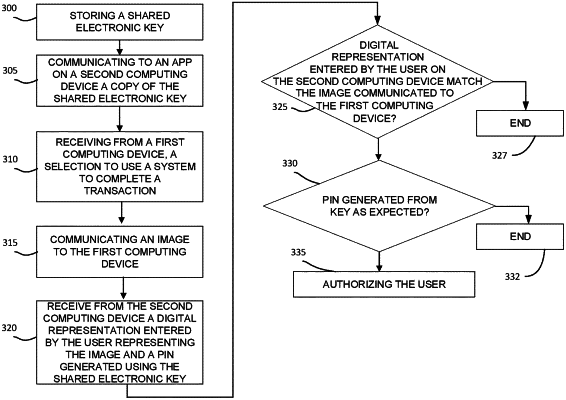| CPC H04L 63/0838 (2013.01) [G06Q 20/3825 (2013.01); G06Q 20/3827 (2013.01); G06Q 20/385 (2013.01); G06Q 20/4012 (2013.01); H04L 9/3242 (2013.01); H04L 63/102 (2013.01)] | 20 Claims |

|
1. A method of electronic authentication comprising:
receiving, at an authentication server, a plurality of drawings of an object from a user via a first computing device over a communications channel during a registration of the first computing device with a payment system, wherein the plurality of drawings of the object are used as an authentication image, and wherein the authentication image comprises a plurality of image pixels;
storing, at the authentication server, a shared electronic key;
communicating, from the authentication server over the communications channel, to an application on a second computing device a copy of the shared electronic key;
receiving, at the authentication server, from the first computing device, a selection from the user to use the payment system to complete a transaction;
communicating, over the communications channel, the authentication image to the first computing device;
receiving, at the authentication server, from the second computing device a digital representation entered by the user representing the authentication image and a PIN calculated using the copy of the shared electronic key, wherein the digital representation comprises a plurality of digital representation pixels;
analyzing, using artificial intelligence by the payment system, the digital representation entered by the user to learn the user's drawing behavior;
determining, via the authentication server, whether the digital representation entered by the user on the second computing device matches the authentication image communicated to the first computing device by comparing the plurality of image pixels to the plurality of digital representation pixels, wherein the comparison comprises the steps of:
calculating a distance between each pixel of the plurality of image pixels to each pixel of the plurality of digital representation pixels,
calculating a sum of the distances between each pixel of the plurality of image pixels and each pixel of the plurality of digital representation pixels,
comparing the sum to a threshold,
adjusting the threshold based on the learned user's drawing behavior, and
in response to the sum being less than the adjusted threshold, determining that the digital representation matches the authentication image;
determining, via the authentication server, whether the PIN is as an expected number;
in response to determining the digital representation entered by the user matches the authentication image and the PIN from the second computing device is the expected number, authorizing the user, via the authentication server, to perform the transaction.
|